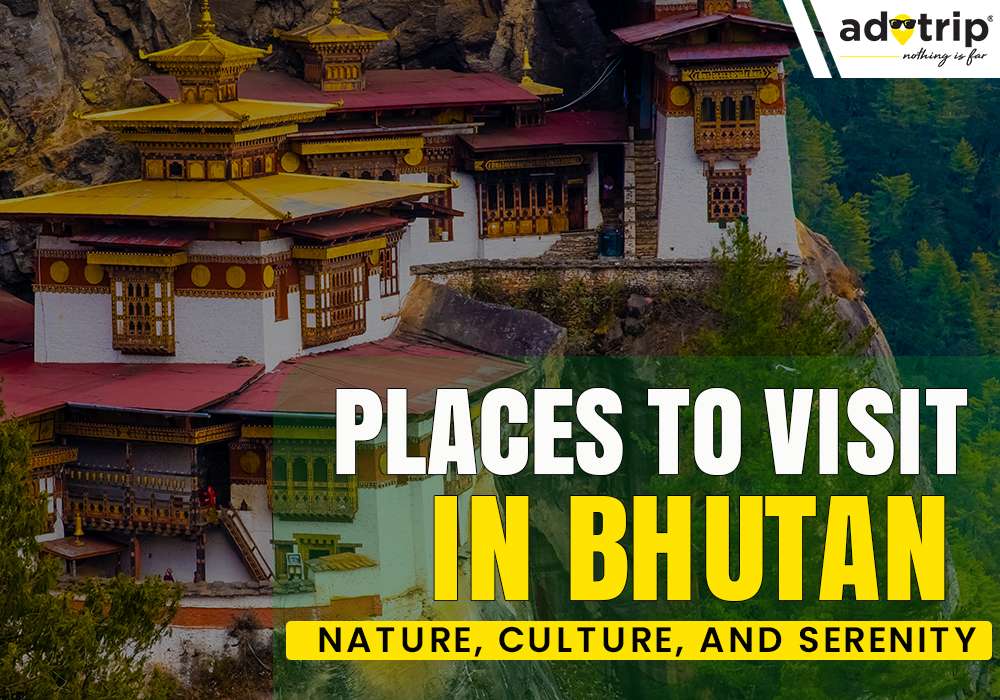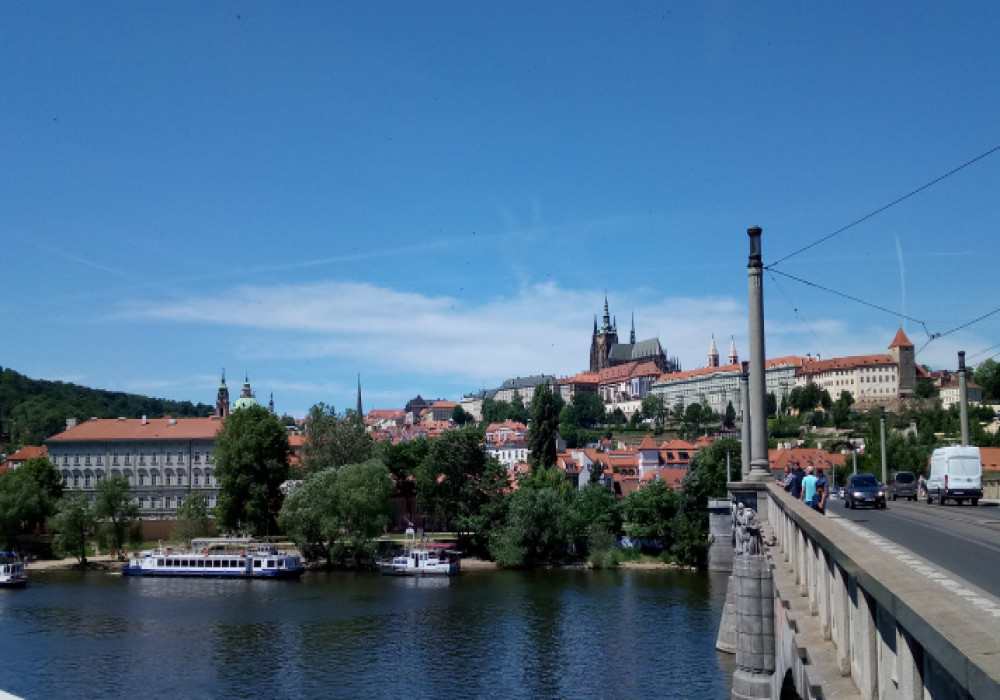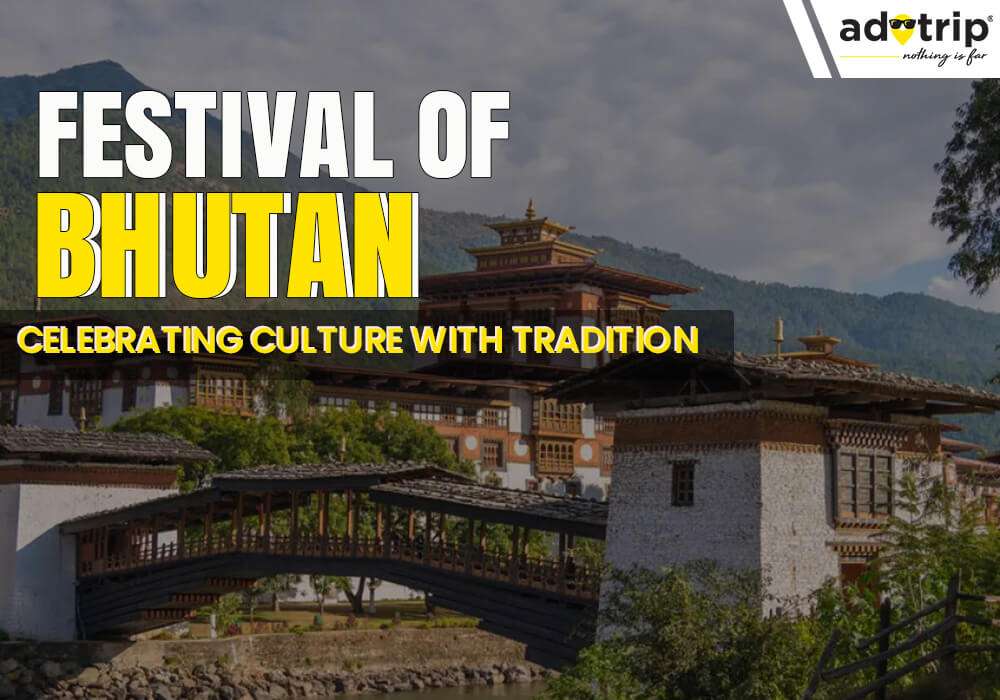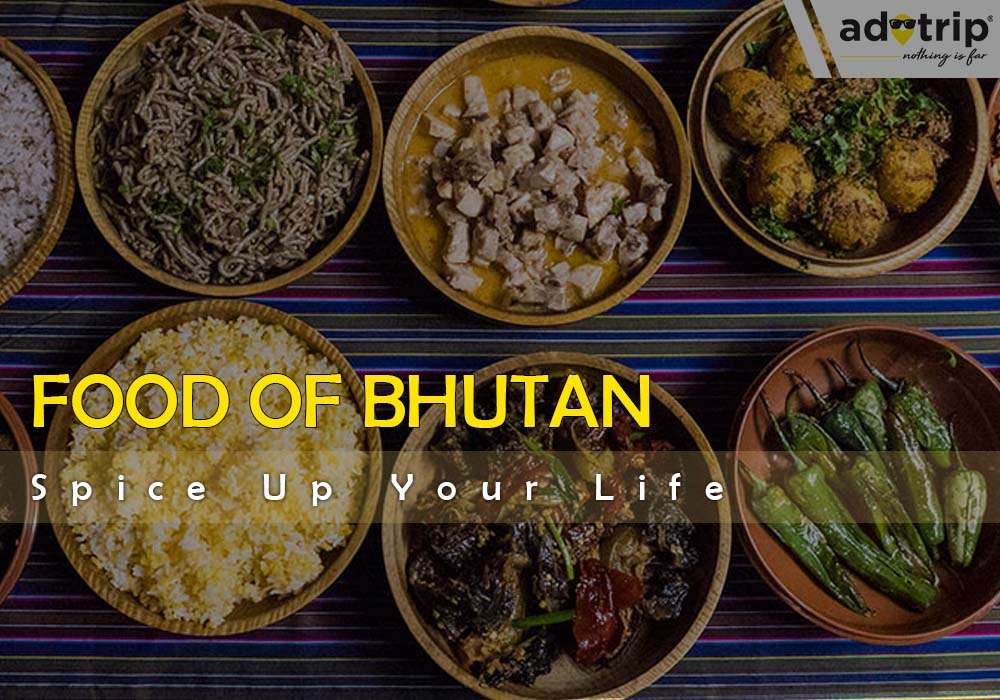
Last Updated At: 21-Sep-2023
Top 10 Places to Visit in Bhutan : Nature, Culture, and Serenity
Bhutan is a mysterious nation that seduces visitors with its natural beauty, rich culture, and quiet spirituality. It is hidden among the majestic peaks of the Eastern Himalayas. From the dangerously placed Tiger's Nest Monastery to the vibrant capital city of Thimphu, where tradition and modernity effortlessly coexist, this enchanted land provides a tapestry of experiences. Explore the majestic Haa Valley, the serene Bumthang Valley, and the historic Punakha Dzong. There are also trekking routes in Bhutan. Bhutan is a must-visit location for people looking for a sublime experience because of its peaceful coexistence of environment and culture.
Top 10 Places to Visit in Bhutan
Bhutan, a Himalayan paradise, offers enchanting destinations. Explore Paro's stunning Tiger's Nest Monastery, immerse in Thimphu's vibrant culture, and witness Punakha's majestic dzongs. Visit the serene Phobjikha Valley, discover the hidden gem of Haa Valley, and embrace the spiritual aura of Bumthang. Bhutan is a land of breathtaking beauty and spirituality. Here some of the must-see Places in Bhutan are as follows:
- Paro Taktsang | a Religious Monument Located on a Cliff
- Thimphu | Bhutan's Capital City
- Punakha Dzong | A Magnificent Fortification Encircled by a Lovely River
- Bumthang Valley | A Place of Tranquillity and Spirituality
- Phobjikha Valley | Magnificent Landscape and the Gangtey Monastery
- Haa Valley | A Secret Treasure That Offers Peace and Culture
- Trongsa | Bhutan's Central Region Has Historical Significance
- Rinpung Dzong | Stunning Fortress and Monastery
- Chele La Pass | Tallest Pass With a Vista of the Mountains
- Jigme Dorji National Park | Bhutan's Natural Wonders and Animals
1. Paro Taktsang | A Religious Monument Located on a Cliff
One of the hidden Gems of Bhutan is Paro Taktsang, also known as Tiger's Nest Monastery, which is perched precipitously on the edge of a cliff. This magnificent temple structure represents religious fervour and provides stunning views of the Paro Valley below. The monastery where Guru Rinpoche is said to have meditated is a popular Buddhist pilgrimage site. To get there, it is a pleasant trek through lush forests and stunning vistas on the strenuous hike.
- Location. Taktsang Trail, Paro, Bhutan
- Entry Fee. 2,000 Nu
2. Thimphu | Bhutan's Capital City
Bhutan's lovely capital city of Thimphu offers a special fusion of history and modernity. You may discover historic monasteries and hopping markets surrounded by lush hills. A magnificent fortress monastery known as the Tashichho Dzong serves as a representation of Bhutan's vibrant culture. However, Thimphu embraces modernity with its lively environment, stores, and cafes. It provides access to Bhutan's cultural riches and insight into its changing character.
- Location. Thimphu, Bhutan
- Entry Fee. Free
3. Punakha Dzong | A Magnificent Fortification Encircled by a Lovely River
Bhutan's Punakha Dzong is a magnificent work of architecture at the meeting point of the Mo Chhu and Pho Chhu rivers. This magnificent fortification, also known as the "Palace of Great Happiness," is a wonderful example of Bhutanese craftsmanship. It is a beautiful location with whitewashed walls decorated with artistic artwork and vivid plants. The Punakha Dzong, a significant seat of governance and the winter home of the monastic body, has historical and theological significance beyond its visual value.
- Location. Punakha, Bhutan
- Entry Fee. Nu 300
4. Bumthang Valley | A Place of Tranquillity and Spirituality
The calm and spiritual Bumthang Valley is located in the middle of Bhutan. This charming area is frequently called the "Switzerland of Bhutan" because of its verdant green hills and unspoiled vistas. Bhutanese spirituality is centred there because of the numerous historic monasteries and temples that dot it. Bumthang Valley offers a tranquil and comprehensive cultural experience, whether exploring Jakar Dzong, visiting holy places like Kurjey Lhakhang, or savouring the quiet beauty.
- Location. Bumthang Valley, Jakar, Bhutan
- Entry Fee. Free
5. Phobjikha Valley | Magnificent Landscape and the Gangtey Monastery
A stunning and unspoiled Bhutan tourist attraction is the Phobjikha Valley, tucked away high in the Himalayas. In addition to being well known for its outstanding natural beauty, this glacier valley serves as the yearly wintering location for the critically endangered black-necked cranes. This valley's mystery is heightened by the Gangtey Monastery, which is positioned on a hill and overlooks it. The Phobjikha Valley offers a unique chance to get in touch with nature and take in the majesty of these magnificent birds in a peaceful environment.
- Location. Phobjikha, Bhutan
- Entry Fee. Nu 120 for International tourists, Nu 15 for local Bhutanese visitors
6. Haa Valley | A Secret Treasure That Offers Peace and Culture
Haa Valley, a well-kept secret in the western region of Bhutan, is renowned for its pristine beauty and extensive cultural legacy. It is a quiet refuge that is surrounded by untamed mountains and stands in stark contrast to the busy cities. You may take in the local culture here, discover traditional Bhutanese architecture, and visit revered temples. For those looking for an authentic Bhutanese experience, Haa Valley continues to be off the beaten road and provides a tranquil haven.
- Location. Haa in Bhutan
- Entry Fee. Free
7. Trongsa | Bhutan's Central Region Has Historical Significance
Trongsa, a town of historic and strategic significance, is tucked away in the central Bhutanese mountains. The Trongsa Dzong, an architectural wonder situated abruptly on a ridge, is its best achievement. This castle was essential to the unity of Bhutan and represents the country's lengthy history. The dzong's exquisite architecture, historical relics, and breathtaking views of the surroundings can all be explored by visitors. Travellers are drawn to Trongsa by its calm beauty and cultural sites in Bhutan.
- Location. Trongsa, Bhutan
- Entry Fee. Free
8. Rinpung Dzong | Stunning Fortress and Monastery
Bhutan's scenic town of Paro is home to the stunning fortress monastery Rinpung Dzong, usually Paro Dzong. This stunning architecture is surrounded by beautiful vegetation and is situated next to the Paro River. It is a recognisable representation of Bhutanese heritage because of its tall castle and whitewashed walls covered in beautiful paintings. In addition to its stunning architecture, Rinpung Dzong holds lively annual festivities that draw tourists and devotees looking to experience Bhutanese culture and spirituality in a captivating environment.
- Location. Rinpung Dzong, Paro, Bhutan
- Entry Fee. Free
9. Chele La Pass | Tallest Pass With a Vista of the Mountains
Bhutan's Chele La Pass, the highest motorable road in the country, is a high mountain pass. At more than 3,900 meters above sea level, it provides breathtaking panoramic views of the Himalayas. Due to the twisting routes through deep forests and alpine meadows, getting to this pass is an experience in and of itself. Chele La Pass offers a unique opportunity to view Bhutan's pristine landscapes and breathtaking panoramas, making it a haven for nature lovers and photographers.
- Location. Chele La, Bhutan
- Entry Fee. Free
10. Jigme Dorji National Park | Bhutan's Natural Wonders and Animals
Bhutan's largest protected region, Jigme Dorji National Park, is a pristine haven. It features a variety of environments, from lush subtropical woods to rocky alpine regions, and is named after the nation's third king. This national park is a paradise for nature lovers and environmentalists wanting to see Bhutan's abundant biodiversity in a natural setting. It is home to various animals, including snow leopards, takins, and red pandas.
- Location. Jigme Dorji National Park, Gasa, Bhutan
- Entry Fee. NU 150
Choose Adotrip to craft your Bhutan adventure, where each journey is a story waiting to be told. Our expertly designed itineraries lead you through Bhutan's mystical valleys, ancient monasteries, and serene landscapes. We ensure seamless travel logistics, immersing you in this Himalayan gem's culture, spirituality, and beauty. We ensure your Bhutan exploration transcends expectations, offering you a once-in-a-lifetime experience.
With us, nothing is far!
Frequently Asked Questions About Places to See in Bhutan
Q1. What role do festivals play in Bhutanese society?
A1. Festivals are essential to Bhutanese culture because they promote harmony and religious piety. They provide a feeling of identity by showcasing bright costumes, celebrating traditions, and tying individuals to their rich cultural history.
Q2. How are Bhutanese festivals connected to religious practices?
A2. Bhutanese festivals combine spirituality and celebration and are frequently based on Buddhism. They incorporate religious rites, masked dances (Cham), and offerings to deities, highlighting the close relationship between religious celebrations and popular culture.
Q3. Are festivals like Tshechus more about spirituality or entertainment?
A3. Bhutanese tshechu successfully combines entertainment and spirituality. They perform holy dances and ceremonies to honour religious traditions and give the community entertainment and occasions for a cultural celebration.
Q4. What are the common features of Bhutanese festival celebrations?
A4. Bhutanese festivals frequently include ceremonial offerings, masked dances, religious rites, colourful costumes (Rachu and Kabney), and community involvement. These components work together to produce an exceptional and spiritually enlightening cultural experience.
Q5. How do Bhutanese festivals often involve mask dances and costumes?
A5. As symbolic depictions of deities and historical personalities, mask dances (Cham) and costumes (Rachu and Kabney) are key to Bhutanese festivities. Attendees are captivated by these performances as they convey spiritual themes and cultural emotions.
Q6. Are festivals in Bhutan open to tourists and visitors?
A6. Yes, tourists and other visitors are frequently welcome at Bhutanese celebrations. They provide an exceptional chance to experience vibrant customs and become immersed in Bhutanese culture, but additional costs and restrictions may exist.
Q7. How do festivals contribute to a sense of community and cultural identity?
A7. By uniting people to celebrate common customs, rituals, and values, festivals in Bhutan strengthen a feeling of community and cultural identity. This boosts ethnic pride.
Q8. Are there any specific taboos or behaviours to consider when attending Bhutanese festivals?
A8. Visitors should dress modestly, refrain from interfering with rituals, and keep their hands off holy artefacts when they attend Bhutanese festivities. Respect regional traditions, be considerate of noise, and ask permission before taking pictures.
Q9. What festivals are celebrated beyond the major Tshechus?
A9. Beyond the major Tshechus, Bhutan celebrates various other festivals, including-
- Paro Tsechu
- Jambay Lhakhang Drup
- Haa Summer Festival
- Trongsa Tsechu
- Nimalung Festival
- Ura Yakchoe
Q10. How have festivals in Bhutan adapted to modern changes while maintaining their traditions?
A10. To balance tradition and progress, Bhutanese festivals have embraced modernisation by adding technology, better logistics, and greater accessibility for tourists while preserving fundamental traditions, including religious rites, mask dances, and cultural values.
--- Published By Adotrip
Latest Blogs

Long Weekends In India 2025 - List of Holidays

Kazakhstan Travel Guide 2025: Affordable Luxury, Visa Free E...

Think Ayodhya is Just Temples? Discover Its Hidden Artistic...

Why Azerbaijan is the Best Budget Friendly Alternative to Sw...










 (1).jpg)


 Dubai
Dubai Malaysia
Malaysia USA
USA





